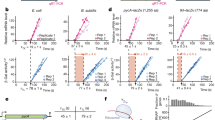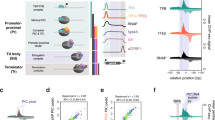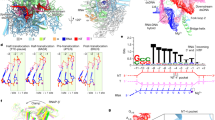Abstract
Tight coordination between transcription and translation is crucial to maintaining the integrity of gene expression in bacteria, yet how bacteria manage to coordinate these two processes remains unclear. Possible direct physical coupling between the RNA polymerase and ribosome has been thoroughly investigated in recent years. Here, we quantitatively characterize the transcriptional kinetics of Escherichia coli under different growth conditions. Transcriptional and translational elongation remain coordinated under various nutrient conditions, as previously reported. However, transcriptional elongation was not affected under antibiotics that slowed down translational elongation. This result was also found by introducing nonsense mutation that completely dissociated transcription from translation. Our data thus provide direct evidence that translation is not required to maintain the speed of transcriptional elongation. In cases where transcription and translation are dissociated, our study provides quantitative characterization of the resulting process of premature transcriptional termination (PTT). PTT-mediated polarity caused by translation-targeting antibiotics substantially affected the coordinated expression of genes in several long operons, contributing to the key physiological effects of these antibiotics. Our results also suggest a model in which the coordination between transcriptional and translational elongation under normal growth conditions is implemented by guanosine tetraphosphate.
This is a preview of subscription content, access via your institution
Access options
Access Nature and 54 other Nature Portfolio journals
Get Nature+, our best-value online-access subscription
$29.99 / 30 days
cancel any time
Subscribe to this journal
Receive 12 digital issues and online access to articles
$119.00 per year
only $9.92 per issue
Buy this article
- Purchase on Springer Link
- Instant access to full article PDF
Prices may be subject to local taxes which are calculated during checkout






Similar content being viewed by others
Data availability
The key data that support the findings of this study are summarized in the Supplementary tables. Other details are available from the corresponding author upon request.
References
Gowrishankar, J. & Harinarayanan, R. Why is transcription coupled to translation in bacteria? Mol. Microbiol. 54, 598–603 (2004).
McGary, K. & Nudler, E. RNA polymerase and the ribosome: the close relationship. Curr. Opin. Microbiol. 16, 112–117 (2013).
Vogel, U. & Jensen, K. F. The RNA chain elongation rate in Escherichia coli depends on the growth rate. J. Bacteriol. 176, 2807–2813 (1994).
Proshkin, S., Rahmouni, A. R., Mironov, A. & Nudler, E. Cooperation between translating ribosomes and RNA polymerase in transcription elongation. Science 328, 504–508 (2010).
Newton, W. A., Beckwith, J. R., Zipser, D. & Brenner, S. Nonsense mutants and polarity in the lac operon of Escherichia coli. J. Mol. Biol. 14, 290–296 (1965).
Elgamal, S., Artsimovitch, I. & Ibba, M. Maintenance of transcription–translation coupling by elongation factor P. mBio 7, e01373–16 (2016).
Adhya, S. & Gottesman, M. Control of transcription termination. Annu. Rev. Biochem. 47, 967–996 (1978).
Richardson, J. P. Preventing the synthesis of unused transcripts by Rho factor. Cell 64, 1047–1049 (1991).
Kohler, R., Mooney, R. A., Mills, D. J., Landick, R. & Cramer, P. Architecture of a transcribing-translating expressome. Science 356, 194–197 (2017).
Miller, O. L. Jr., Hamkalo, B. A. & Thomas, C. A. Jr. Visualization of bacterial genes in action. Science 169, 392–395 (1970).
Demo, G. et al. Structure of RNA polymerase bound to ribosomal 30S subunit. eLife 6, e28560 (2017).
Fan, H. et al. Transcription–translation coupling: direct interactions of RNA polymerase with ribosomes and ribosomal subunits. Nucleic Acids Res. 45, 11043–11055 (2017).
Burmann, B. M. et al. A NusE:NusG complex links transcription and translation. Science 328, 501–504 (2010).
Saxena, S. et al. Escherichia coli transcription factor NusG binds to 70S ribosomes. Mol. Microbiol. 108, 495–504 (2018).
Burmann, B. M. et al. An alpha helix to beta barrel domain switch transforms the transcription factor RfaH into a translation factor. Cell 150, 291–303 (2012).
Chen, M. & Fredrick, K. Measures of single- versus multiple-round translation argue against a mechanism to ensure coupling of transcription and translation. Proc. Natl Acad. Sci. USA 115, 10774–10779 (2018).
Bremer, H. & Dennis, P. P. in Escherichia coli and Salmonella 2nd edn (ed. Neidhardt, F. C.) 1553–1569 (American Society of Microbiology, 1996).
Iyer, S., Park, B. R. & Kim, M. Absolute quantitative measurement of transcriptional kinetic parameters in vivo. Nucleic Acids Res. 44, e142 (2016).
Dai, X. et al. Slowdown of translational elongation in Escherichia coli under hyperosmotic stress. mBio 9, e02375–18 (2018).
Dai, X. et al. Reduction of translating ribosomes enables Escherichia coli to maintain elongation rates during slow growth. Nat. Microbiol. 2, 16231 (2016).
Zhu, M., Dai, X. & Wang, Y. P. Real time determination of bacterial in vivo ribosome translation elongation speed based on LacZα complementation system. Nucleic Acids Res. 44, e155 (2016).
Schleif, R., Hess, W., Finkelstein, S. & Ellis, D. Induction kinetics of the l-arabinose operon of Escherichia coli. J. Bacteriol. 115, 9–14 (1973).
Bennett, P. M. & Maaloe, O. The effects of fusidic acid on growth, ribosome synthesis and RNA metabolism in Escherichia coli. J. Mol. Biol. 90, 541–561 (1974).
Seo, H. S. et al. EF-G-dependent GTPase on the ribosome. Conformational change and fusidic acid inhibition. Biochemistry 45, 2504–2514 (2006).
Richardson, L. V. & Richardson, J. P. Rho-dependent termination of transcription is governed primarily by the upstream Rho utilization (rut) sequences of a terminator. J. Biol. Chem. 271, 21597–21603 (1996).
Graham, J. E. & Richardson, J. P. rut sites in the nascent transcript mediate Rho-dependent transcription termination in vivo. J. Biol. Chem. 273, 20764–20769 (1998).
Ruteshouser, E. C. & Richardson, J. P. Identification and characterization of transcription termination sites in the Escherichia coli lacZ gene. J. Mol. Biol. 208, 23–43 (1989).
Harvey, R. J. & Koch, A. L. How partially inhibitory concentrations of chloramphenicol affect the growth of Escherichia coli. Antimicrob. Agents Chemother. 18, 323–337 (1980).
Maguire, B. A. Inhibition of bacterial ribosome assembly: a suitable drug target? Microbiol. Mol. Biol. Rev. 73, 22–35 (2009).
Hui, S. et al. Quantitative proteomic analysis reveals a simple strategy of global resource allocation in bacteria. Mol. Syst. Biol. 11, 784 (2015).
Potrykus, K. & Cashel, M. p)ppGpp: still magical? Annu. Rev. Microbiol. 62, 35–51 (2008).
Vogel, U., Sorensen, M., Pedersen, S., Jensen, K. F. & Kilstrup, M. Decreasing transcription elongation rate in Escherichia coli exposed to amino acid starvation. Mol. Microbiol. 6, 2191–2200 (1992).
Vogel, U. & Jensen, K. F. Effects of guanosine 3′,5′-bisdiphosphate (ppGpp) on rate of transcription elongation in isoleucine-starved Escherichia coli. J. Biol. Chem. 269, 16236–16241 (1994).
Iyer, S., Le, D., Park, B. R. & Kim, M. Distinct mechanisms coordinate transcription and translation under carbon and nitrogen starvation in Escherichia coli. Nat. Microbiol. 3, 741 (2018).
Kingston, R. E., Nierman, W. C. & Chamberlin, M. J. A direct effect of guanosine tetraphosphate on pausing of Escherichia coli RNA polymerase during RNA chain elongation. J. Biol. Chem. 256, 2787–2797 (1981).
Furman, R., Sevostyanova, A. & Artsimovitch, I. Transcription initiation factor DksA has diverse effects on RNA chain elongation. Nucleic Acids Res. 40, 3392–3402 (2012).
Klumpp, S., Zhang, Z. & Hwa, T. Growth rate-dependent global effects on gene expression in bacteria. Cell 139, 1366–1375 (2009).
Schreiber, G. et al. Overexpression of the relA gene in Escherichia coli. J. Biol. Chem. 266, 3760–3767 (1991).
Svitil, A. L., Cashel, M. & Zyskind, J. W. Guanosine tetraphosphate inhibits protein synthesis in vivo. A possible protective mechanism for starvation stress in Escherichia coli. J. Biol. Chem. 268, 2307–2311 (1993).
Hernandez, V. J. & Bremer, H. Guanosine tetraphosphate (ppGpp) dependence of the growth rate control of rrnB P1 promoter activity in Escherichia coli. J. Biol. Chem. 265, 11605–11614 (1990).
Ryals, J., Little, R. & Bremer, H. Control of rRNA and tRNA syntheses in Escherichia coli by guanosine tetraphosphate. J. Bacteriol. 151, 1261–1268 (1982).
Shibuya, M. & Kaziro, Y. Studies on stringent control in a cell-free system. Regulation by guanosine-5′-diphosphate-3′-diphosphate of the synthesis of elongation factor Tu. J. Biochem. 86, 403–411 (1979).
Zhu, M. & Dai, X. Growth suppression by altered (p)ppGpp levels results from non-optimal resource allocation in Escherichia coli. Nucleic Acids Res. 47, 4684–4693 (2019).
Scott, M., Klumpp, S., Mateescu, E. M. & Hwa, T. Emergence of robust growth laws from optimal regulation of ribosome synthesis. Mol. Syst. Biol. 10, 747 (2014).
Siibak, T. et al. Erythromycin- and chloramphenicol-induced ribosomal assembly defects are secondary effects of protein synthesis inhibition. Antimicrob. Agents Chemother. 53, 563–571 (2009).
Scott, M., Gunderson, C. W., Mateescu, E. M., Zhang, Z. & Hwa, T. Interdependence of cell growth and gene expression: origins and consequences. Science 330, 1099–1102 (2010).
Saxena, S. & Gowrishankar, J. Modulation of Rho-dependent transcription termination in Escherichia coli by the H-NS family of proteins. J. Bacteriol. 193, 3832–3841 (2011).
Nieto, J. M., Bailey, M. J., Hughes, C. & Koronakis, V. Suppression of transcription polarity in the Escherichia coli haemolysin operon by a short upstream element shared by polysaccharide and DNA transfer determinants. Mol. Microbiol. 19, 705–713 (1996).
Cayley, S., Lewis, B. A., Guttman, H. J. & Record, M. T. Jr. Characterization of the cytoplasm of Escherichia coli K-12 as a function of external osmolarity. Implications for protein-DNA interactions in vivo. J. Mol. Biol. 222, 281–300 (1991).
Ihara, Y., Ohta, H. & Masuda, S. A highly sensitive quantification method for the accumulation of alarmone ppGpp in Arabidopsis thaliana using UPLC-ESI-qMS/MS. J. Plant Res. 128, 511–518 (2015).
Acknowledgements
We are grateful to M. Kim and R. Balakrishnan for discussions. X.D. and M.Z. acknowledge the support of the National Natural Science Fund of China (grant Nos. 31700089, 31700039 and 31870028) and by CCNU (self-determined research funds of CCNU from the college’s basic research and operation of MOE, grant Nos. CCNU18QN028, CCNU18KFY01, CCNU19TS028 and CCNU18ZDPY05). M.M. and T.H. acknowledge the support of the NIH through grant No. R01GM095903.
Author information
Authors and Affiliations
Contributions
X.D. and T.H. designed and supervised the study. M.Z. and X.D. performed all the experiments including strain construction, cell growth, RT–qPCR-based transcriptional kinetics, translational kinetics and RNA and total protein quantification. M.Z., X.D. and T.H. analysed the experimental data. X.D., T.H. and M.Z. wrote the main text and Supplementary information. M.M. analysed the data of premature transcriptional termination and wrote the Supplementary notes.
Corresponding authors
Ethics declarations
Competing interests
The authors declare no competing interests.
Additional information
Publisher’s note: Springer Nature remains neutral with regard to jurisdictional claims in published maps and institutional affiliations.
Supplementary information
Supplementary Information
Supplementary Notes, Supplementary Tables 1 and 2, Supplementary Figs. 1–19 and Supplementary References.
Rights and permissions
About this article
Cite this article
Zhu, M., Mori, M., Hwa, T. et al. Disruption of transcription–translation coordination in Escherichia coli leads to premature transcriptional termination. Nat Microbiol 4, 2347–2356 (2019). https://doi.org/10.1038/s41564-019-0543-1
Received:
Accepted:
Published:
Issue Date:
DOI: https://doi.org/10.1038/s41564-019-0543-1
This article is cited by
-
Co-transcriptional gene regulation in eukaryotes and prokaryotes
Nature Reviews Molecular Cell Biology (2024)
-
Incomplete transcripts dominate the Mycobacterium tuberculosis transcriptome
Nature (2024)
-
Transcription–replication interactions reveal bacterial genome regulation
Nature (2024)
-
Transcription Needs Translation Initiation of the Downstream Gene to Continue Downstream at Intercistronic Junctions in E. Coli
Current Microbiology (2024)
-
High-resolution landscape of an antibiotic binding site
Nature (2023)



